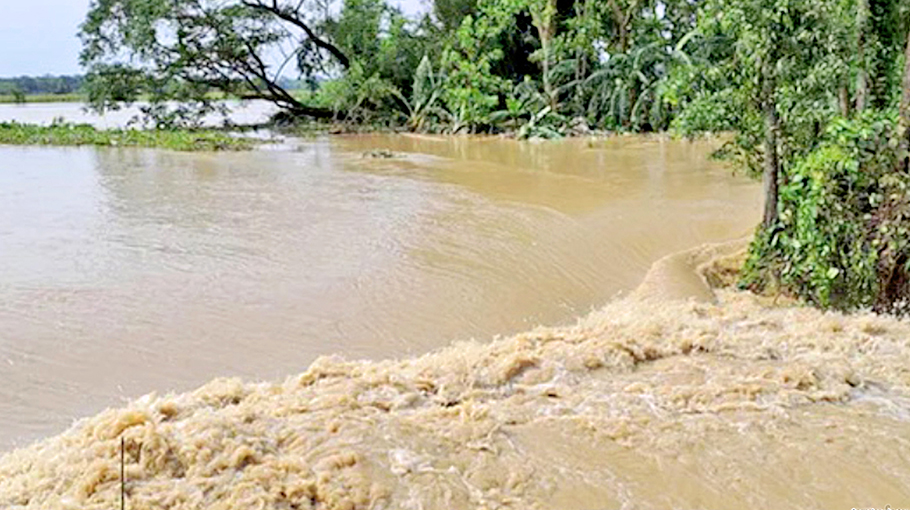Downpour floods vast areas in Sylhet
20 lakh people marooned, dyke gives in


Flash flood this season has caused colossal damage to crops on vast areas in the wetlands in the north-eastern regions of Sylhet while over 20 lakh people marooned due to the flood.
The severity of the flood has been described as one of the worst since the last major flood in the region in 2004 when huge crops were destroyed while forcing people to take shelter elsewhere.
Officials said that hundreds of thousands of people in Sylhet and Sunamganj districts were marooned due to the flood. At least 20 lakh people in the two districts have been directly and indirectly affected by the flood since May 12.
The overall flood situation in Sylhet has not improved, despite inundation for over a week. New areas of the district have been inundated since early Friday. Apart from 13 upazilas of the district, the flood also submerged many parts of the Sylhet city.
On the other hand, many fresh areas of Sunamganj district came under floodwater on Friday and Thursday. Three hospitals in the district have been flooded. As a result, the health service has been disrupted there.
The hospitals are Sunamganj Chest Disease Hospital in the district town, Kaitak 20-bed Hospital in Chhatak upazila and Tahirpur Upazila Health Complex.
Floodwater has inundated the ground floor of the hospitals. Somewhere the residential quarters of the doctors have also been flooded. Both the patients and the doctors have been suffering from the situation, said Abdullah Al Beruni Khan, deputy civil surgeon of Sunamganj.
The overall flood situation is worsening, officials said. Many roads and bridges in the Haor-based district collapsedand communications have been cut off in some places. Many educational institutions, government and non-government institutions are now under floodwater. Meanwhile, shelter centres have been opened in some areas.
The Deputy Commissioner (DC) of Sunamganj Jahangir Hossain said that 15 shelter centres were opened in different places, including Chhatak and Doarabazar upazilas. Dry food was distributed there, while rice and packets of dry food were also allocated in the district for distribution among flood-hit people.
Meanwhile, the flood situation in Sylhet may further worsen. According to the Sylhet Water Development Board (WDB), river water has never risen so much since 2004. This is the biggest flood in the last 18 years.
However, some people said that this flood exceeded the 2004 flood. Mijanur Rahman, a resident of Mirboxtula area in Sylhet city who hails from Kanaighat upazila; Foyez Ahmed, former president of Jaintiapur upazila, Manjur Ahmed, a resident of Alirgaon area at Goainghat upazila, and some others expressed such an opinion.
The Surma and Kushiyara rivers were continuing to flow above the danger level due to the onrush of hilly waters from the upstream. India’s Cherrapunjee, upstream of Sylhet, experienced 2,200 mm of rainfall in eight days till Thursday, resulting in rising water levels of many rivers in Sylhet.
According to the Flood Forecasting and Warning Centre, the Surma was flowing 98cm above the danger level at Kanaighat point at 9:00am on Friday, while it was flowing 38cm above the danger level at the Sylhet city point and 16cm at the Sunamganj city point.
The Kushiyara was flowing 169cm above the danger level at Amalshid area of Zakiganj upazila. However, water of this river increased by one cm at Sheola point of Beayanibazar upazila and flowing 58 cm above the danger level.
Meanwhile, the river protection dam at the confluence of the Barak-Surma-Kushiyara rivers at Amalshid in Zakiganj gave in in the early hours of Friday due to excessive pressure of water flow from the upstream.
Mahfuzur Rahman Bhuiyan, assistant engineer of WDB in Zakiganj, said that nearly 30 metres of river protection dam were breached. Water flow is said to be much higher.
Zakiganj is nearly 92 kilometres from Sylhet town. India’s Barak river branches into the Surma and Kushiyara rivers at the Amolshid area of Zakiganj. The long embankment was built there along the border with India to prevent flooding.
The acting UNO of Zakiganj Pallab Hom Das said that the collapse of the embankment intensified flood in other upazilas. The water was flowing into Surma and Kushiyara rivers at a rapid rate due to damage to the embankment. At the same time, the road communication between Zakiganj and Sylhet town was snapped.
The road communications between Sylhet town and some other upazilas were also snapped. Most areas of Kanaighat, Jaintiapur, Gowainghat, Sylhet Sadar, Fenchuganj, Companiganj upazilas were also inundated by flood, snapping road connections there.
DC of Sylhet Mohammad Mojibar Rahman said that shelter centres were opened in every flood-affected upazila. Food aid has also been provided. UNO of Jaintapur Al Bashirul Islam said that they already distributed relief, dry food, and water purification tablets to flood victims.
Meanwhile, the plight of the flood-hit people is getting worse. There is a shortage of dry food and drinking water. Many are living on wooden platforms after water entered their homes. Waterborne diseases are also spreading rapidly.
Although the government promised to provide relief, many did not get it as road communications between Sylhet city and several other places have been cut off. The flood-hit people of Sylhet city are also facing a food and water crisis.
Several crop fields have been inundated. According to the Sylhet DAE, 1,301 hectares of Aush paddy field, 1,704 hectares of Boro field and 1,004 hectares of summer vegetables went underwater on Thursday.
Besides, hundreds of students have been hit hard as flooding forced authorities to close educational institutions in Sylhet district. According to the district primary education office, floodwater entered some 550 educational institutions in the district.
Meanwhile, Sylhet Meteorological Department senior meteorologist Sayeed Ahmed Chowdhury said heavy rains are expected in the district till next Sunday. From next Monday or Tuesday, the rainfall may start decreasing.



